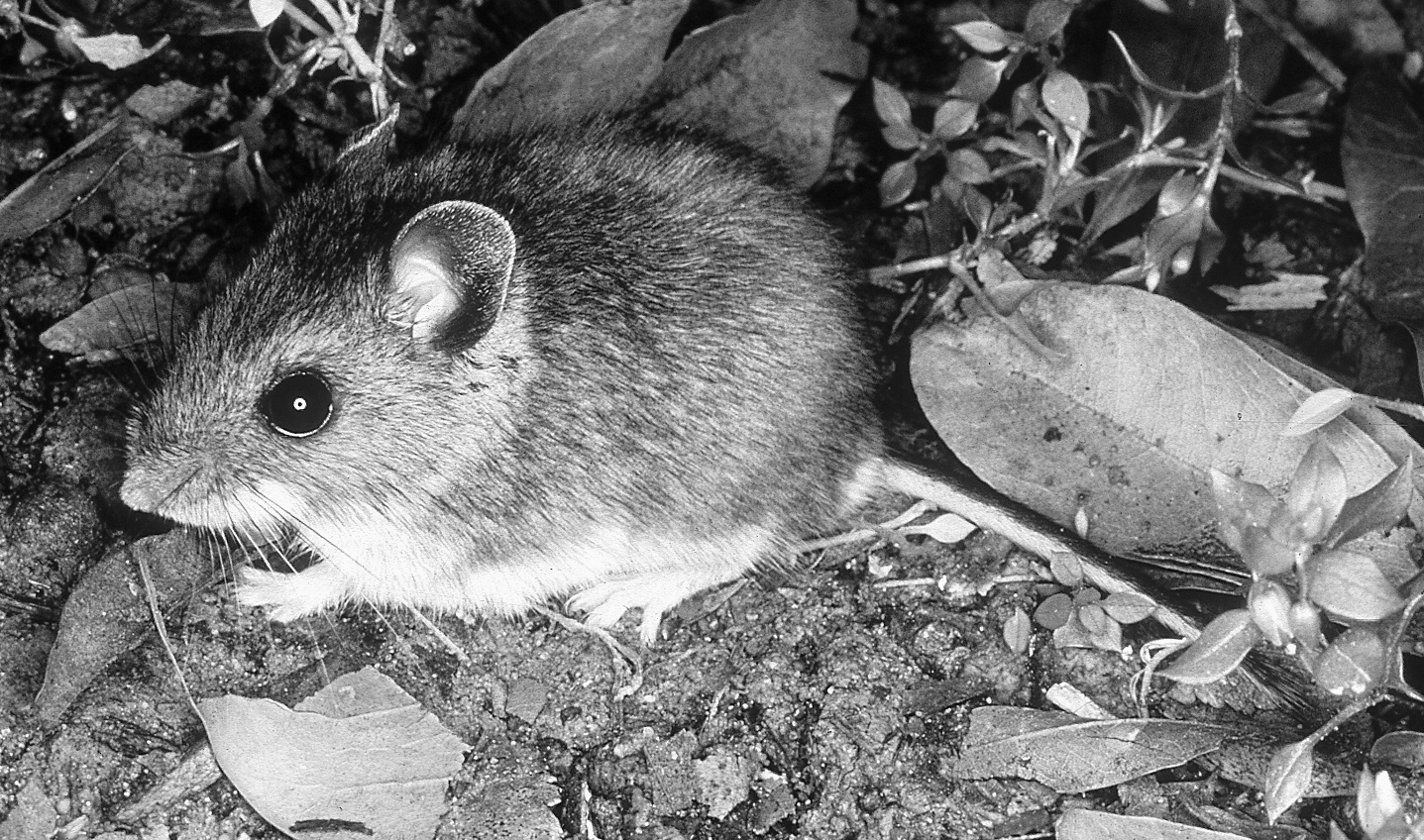NORTH AMERICAN DEERMOUSE
Peromyscus maniculatus (Wagner 1845)
Order Rodentia : Family Cricetidae
DESCRIPTION. A small, white-footed mouse with sharply bicolor tail, white beneath and dark above; ears usually shorter than hind foot, prominent, and leaf-like; upperparts bright fulvous or brownish, intermixed with dusky; underparts and feet white. This species is most easily confused with P. leucopus, from which it differs in a sharply bicolor tail, more hairy and often shorter tail, frequently whitish tufts of hair at base of ears, and usually longer pelage. Dental formula: I 1/1, C 0/0, Pm 0/0, M 3/3 × 2 = 16. Averages for external measurements: total length, 170 mm; tail, 81 mm; hind foot, 20 mm; ear, 18 (12–20) mm. Weight, 15–32 g.

DISTRIBUTION. Statewide but uncommon in the eastern, coastal, and southern parts of the state.

SUBSPECIES. Peromyscus m. blandus in the Trans-Pecos and areas immediately to the east; P. m. luteus in the Panhandle, probably south to Winkler County; P. m. ozarkiarum, which occurs sympatrically with the following race in Cooke, Denton, and Grayson counties; P. m. pallescens in the eastern part of the range in Texas; and possibly P. m. nebrascensis in the northwestern Panhandle. The distribution boundaries and validity of subspecies are in need of revision.
HABITS. These deermice occupy a variety of habitats, ranging from mixed forests to grasslands to open, sparsely vegetated deserts. In Texas, they usually inhabit grasslands or areas of open brush, especially where forbs and grasses offer concealment and a source of food. Weed-choked fencerows and washes offer almost ideal habitat. The North American deermice seem to be poor climbers and live close to or on the ground. They also are known to live commensally with humans and have probably benefited from human activities and habitat alterations since European settlement of the United States.
They are almost strictly nocturnal. Trapping records indicate that they leave their daytime retreats early in the evening and remain abroad until shortly after sun up. They live in underground burrows, in brush piles, or in crevices among rocks. The burrow is simple in design and usually consists of two or three short branches converging from as many surface openings to a single tunnel that slopes steeply to the globular nest chamber, which is 7–10 cm in diameter. The nests are hollow balls of dry grass, shredded weed stems, and other available material including rabbit fur and bird feathers.
North American deermice do not hibernate. Their winter activities may include taking up quarters in a pile of logs, from which they venture nightly in search of food. The tracks of one mouse led from the logs to one bush after another in a wandering fashion to the edge of a bare field some 100 m (328 ft.) distant and then back to the log pile. The others traveled <50 m from their nest. Bits of bark, leaves, and seed coats scattered on the snow beneath many of the bushes indicated that the deermice had climbed into them in quest of food. Their food consists of a variety of items, primarily seeds. Depending on the season, fruits, bark, roots, and vegetation may be consumed.
They breed in every month of the year, with peaks in the periods from January through April and from June through November. More than one litter of young may be produced per year. Litters seem to be born in rapid succession. One captive female produced 11 litters with 42 young in a year. The gestation period varies from 22 to 27 days, averaging about 24 days. Litter size ranges from one to nine, averaging about four. At birth, the pups are blind, pink, and hairless and weigh from 1.1 to 2.3 g. They become pigmented dorsally in about 24 hours, the pinna of the ear unfolds on the third day, the eyes open in 12–17 days, and they are weaned when about 4 weeks old. The longest observed time of suckling was 37 days. Sexual maturity is reached before the young lose their blue juvenile pelage, and females born early in the year may themselves produce young by late summer or early fall.
These deermice are often abundant in favorable habitats, and then as with other animals that overpopulate an area, they may become pests. Because of their tolerance to a wide variety of habitat conditions and their often large population size, they are difficult and expensive to control. Since they are an important source of food for many small carnivores, owls, and snakes, the assistance of those predators should be enlisted in controlling the populations of mice.
POPULATION STATUS. Common. The North American deermouse remains common in the Trans-Pecos and northwestern parts of the state. Populations appear to be decreasing in north and central Texas, presumably due to loss of native grasslands.
CONSERVATION STATUS. The IUCN lists the North American deermouse as a species of least concern, and it does not appear on the federal or state lists of concerned species. The loss of native grassland habitat in the central part of Texas represents a major concern for the future of the subspecies P. m. pallescens from that region. We have attempted without success to collect this subspecies at several localities where it was previously known.
REMARKS. The North American deermouse has been implicated as the primary reservoir for Sin Nombre virus, a strain of hantavirus responsible for hantavirus pulmonary syndrome. A few people, particularly on the High Plains of Texas, have died from this virus, and anyone finding this deermouse in their residence should be cautious. This species has a tendency to inhabit old cabins and buildings, and one should watch for these mice, or evidence of their presence, when cleaning such structures.
From The Mammals of Texas, Seventh Edition by David J. Schmidly and Robert D. Bradley, copyright © 1994, 2004, 2016. Courtesy of the University of Texas Press.
Natural Science Research Laboratory
-
Address
Museum of Texas Tech University, 3301 4th street, Lubbock, TX 79409 -
Phone
806.742.2486 -
Email
nsrl.museum@ttu.edu

